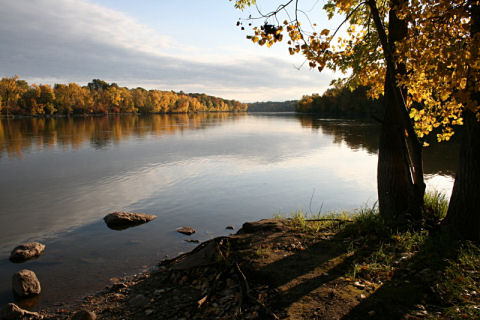
Rapid Croche Photo Compliments of Jim Pinkham
Proposed AIS Control and Monitoring Plan for the Rapide Croche Boat Transfer Station
Prepared by Philip B. Moy, Ph.D.
University of Wisconsin Sea Grant Institute
State statute 237 authorizes the Fox River Navigational System Authority to repair and re-open 16 of the 17 locks on the lower Fox River. Reopening the Fox River locks brings the potential for economic development and revitalization of the river communities but also increases concern for the risk of upstream spread of aquatic invasive species. The lock at Rapide Croche is the site of a fixed barrier to prevent the upstream migration of sea lampreys into the Lake Winnebago chain of lakes. This lock will not be functional. Instead, a boat lift and transfer station will move boats overland from the downstream side of the lock and clean them prior to placement on the upstream side. Protecting the Lake Winnebago sturgeon population and native fisheries from the potential adverse impacts of aquatic invasive species (AIS) must be the primary consideration in the operation of the transfer station and at other system access points.
Boaters wishing to move upstream will have to comply with certain requirements prior to approaching the boat transfer station. The hull must be free of accumulated debris and fouling organisms. Live fish and bait must not be moved above the Rapide Croche lock. Each boat will be completely separated from the downstream water and will be washed with hot water prior to being moved upstream. Removal from the water will ensure that no fish are moved upstream during the transfer operation.
All upstream-bound boats will be first rinsed with sprayed upstream water to dislodge loosely adhering debris from the hull. The boat will then be floated in 110oF water for at least one minute. Water at this temperature will instantaneously kill zebra and quagga mussels as well as most other aquatic organisms. During the boat washing procedure, equipment onboard the boats will be removed, sprayed with a pressure washer then immersed in a tub of 110oF water for at least one minute. The measures recommended in this document will ensure that no live fish, invertebrates or plants are moved upstream at the transfer station. The station cleansing equipment will be designed such that additional cleansing agents can be added to the cleaning procedure as warranted by emerging Great Lakes AIS threats. An Aquatic Invasive Species Hazard Analysis and Critical Control Point (AIS-HACCP) plan and checklists will be developed for quality assurance of the boat cleansing protocol at the site.
Monitoring for aquatic invasive species will take place from May to September. The monitoring will be performed by Lawrence University students under the direction of Dr. Bart DeStasio and will include sampling in the navigation pools up and downstream from Rapide Croche Lock. Sampling methods will target fish and invertebrates. Monitoring has already begun to establish a baseline before the transfer operation commences.
Despite the significant effort proposed herein to prevent the spread of AIS at the Rapide Croche boat transfer station, AIS may still be introduced to the Lake Winnebago system because Rapide Croche is not the sole access point. Over 60 boat access points around the lakes and upper and lower Fox River offer potential entry sites for invasive species on trailered boats. The connection with the Wisconsin River at Portage may also allow AIS access to the system. Law enforcement, education, outreach and cooperation with upstream anglers and boaters are essential for the overall success of the AIS prevention effort.
Find the full detail of the plan below:
Links below to access 2008 final reports:
- 2008 Final Project Report to the Fox River Navigational System Authority
Aquatic Invasive Species Committee Tests of Lethal Temperature Limits for Invasive Species in The Lower Fox River:
Report To the Fox River Navigational System Authority
Or for more information contact:
Harlan P. Kiesow, CEO
(920) 202-1855
hkiesow@new.rr.com
William Bush, AIS Committee Chair
(920) 213-5007
wbush43476@aol.com
Rapide Croche AIS Plan
AIS Control and Monitoring Plan for the Rapide Croche Boat Transfer Station
Prepared by Philip B. Moy, Ph.D.
University of Wisconsin Sea Grant Institute
Introduction
The Rapide Croche Lock is the site of a fixed barrier that prevents upstream migration of spawning sea lamprey (Petromyzon marinus) into Lake Winnebago. At 137,708 acres, Lake Winnebago is the largest inland lake in Wisconsin. Lake Winnebago is home for one of the strongest populations of lake sturgeon (Acipenser fulvescens) in North America (Fred Binkowski, pers. comm.) and supports a strong walleye fishery (WI DNR 2006). Protecting the Lake Winnebago ecosystem, the lake sturgeon and walleye populations from sea lamprey and from the spread of other AIS is a primary consideration in developing a boat transfer facility at the Rapide Croche lock.
Goal
Prevent the upstream spread of aquatic invasive species (AIS) and safely transfer boats at the Fox River Rapide Croche Lock.
Objectives
- Maintain the effectiveness of the lamprey barrier currently in place at the Rapide Croche Lock
- Move boats overland in an environmentally safe manner without moving AIS
- Ensure that the boat cleansing process at the Rapide Croche transfer station meets or exceeds the Wisconsin State and Aquatic Nuisance Species Task Force recreational boating guidelines for AIS prevention.
- Monitor for the presence of fish and invertebrate AIS above and below the Rapide Croche boat transfer station
- Educate system users about AIS prevention
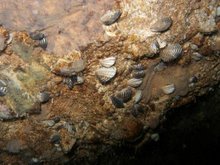
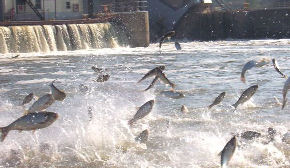
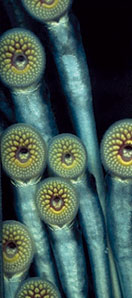
Aquatic Invasive Species
Species currently in the Great Lakes that should be prevented from spreading into the Lake Winnebago System include: lamprey, round goby, smelt, white perch, ruffe, and Great Lakes trout and salmon. Invertebrates include the quagga mussel and the non-indigenous waterfleas (fishhook and spiny waterfleas), rusty crayfish and the bloody red shrimp; plants should be removed because non-native organisms may be entrained with or attached to them. Pathogens that could be moved with fish include spring viremia of carp virus, infectious pancreatic necrosis, bacterial kidney disease and others. Other non-indigenous species or organisms of concern should be added to the list as they appear in Green Bay or the lower Fox River.
The spiny waterflea (Bythotrephes cederstroemi) will likely not thrive in the Lake Winnebago system or in Green Bay. This tiny, planktonic crustacean requires deep lakes that offer a summer thermal refuge. The shallow waters of lakes Winnebago, Winneconne, Poygan and Butte des Morts do not provide such refuge and so are unlikely to offer habitat suitable for this invasive zooplankton. Some shallow New York lakes in contact with spiny waterflea infested rivers have not yet exhibited invasive waterflea populations (Ed Mills pers. comm.) The fishhook waterflea (Cercopagis pengoi) can tolerate warm waters therefore reasonable steps to prevent the introduction of these nonnative crustaceans will be taken. The FRNSA recommends that similar precautions be implemented at the other Winnebago system access points.
This document considers the organisms most likely to be transferred with boats ? those floating in the water column and likely to adhere to or become entrained on boats or associated with fish or aquatic vegetation. Benthic organisms such as New Zealand Mudsnails or the diatom called “didymo” or “rock snot” (Didymosphenia geminata) are more likely to be spread via trailers or anglers as they come in contact with the bottom substrate of lakes and streams rather than by a floating boat.
Target Organisms
Fish
Prohibiting the movement of fish with boats is most easily accomplished by preventing the movement of bait and harvested fish, removing the vessel from the water for transfer and fencing the site to close it during off hours. A greater challenge lies in prohibiting the movement of microscopic resting eggs, larvae or pathogens that could remain in water adhering to equipment on board, the sides, interior spaces and crevices of the vessel. This challenge will be met through an aggressive vessel cleaning protocol that exceeds Wisconsin State and ANS Task Force recommendations.
No fish or bait live or dead will be transported above the Rapide Croche lock. Bait will be confiscated and discarded in the trash. Water in live wells, bilge and motors will be drained and flushed and the hull of the vessel and equipment will be rinsed with 110oF water prior to moving the boat and associated equipment to the upstream side of the lock. Boats moving downstream will not be inspected or cleaned prior to transfer but owners of boats moving downstream will be informed that they will have to meet the AIS prevention requirements to move the boat back upstream.
Quagga and Zebra Mussels
The application of sufficiently heated water can quickly exceed the thermal tolerance of organisms causing mortality within a very short time. The Rapide Croche transfer station will use water at 110oF to assure instantaneous kill of quagga mussels. McMahon et al (1993) determined that at raw water intake structures the maximum temperature required for instantaneous mortality of Dreissena is 43oC (109oF) when mussels were acclimated to 30oC and subjected to a “rapid” heating rate of 1oC/min. The temperature required for instantaneous mortality is reduced with lower acclimation temperatures. McMahon et al (1994) further established an equation for lethal temperatures for 15mm long zebra mussels based on acclimation temperature. Time in hours to achieve 100 percent mortality in Dreissena is described by the following equation:
Total Mortality in Hrs = 40.002 + 0.0514(acclimation temp oC) ? 1.126(test temp oC)
At the boat transfer site, the acclimation temperature would be the temperature of the river water; the test temperature would be the temperature of the wash water. Maximum summer water temperature for the Fox River at Rapide Croche Dam in 2005 was 85oF (29oC). At this maximum “acclimation” temperature the treatment temperature required for instantaneous mortality (death in zero hours) of zebra mussels would be about 98.6oF (37oC). Though similar information is not available for quagga mussels, it is likely this congeneric species has similar thermal tolerance.
Spiny Waterfleas
Spiny waterfleas, both Bythotrephes and Cercopagis are present in Green Bay. These species can reproduce parthenogenetically (without males). During most of the year they do not require males to establish a new population. In the fall as water temperatures fall below 61oF, males appear and females produce resting eggs (Makarewicz et al 2002, MacNeill et al 2004). Resting eggs can survive desiccation for twelve hours before dying and can tolerate hotter water temperatures than adult zebra mussels. At Rapide Croche we need to prevent the movement od adult spiny and fishhook waterfleas and avoid the movement of resting eggs.
The upper lethal limit for spiny waterflea (Bythotrephes longimanus) has been documented as 74oF (23oC) (Yurista, 1999) due to inactivation of respiratory enzymes. The thermal tolerance of adult fishhook waterfleas is not precisely known (MacIsaac, pers. comm.; Aladin, pers. Comm.) Aladin reported the optimum temperature for fishhook waterfleas (Cercopagis pengoi) is 52-72oF (11-22oC) and that this cladoceran may be able to tolerate water temperatures as high as 102.2oF (39oC). However, in Russia, MacIsaac did not find adults in nuclear cooling reservoirs where water temperatures reach 95oF (35oC) and suggested 86oF (30oC) may be an ecological maximum for the organism (pers. comm.).
To avoid moving adult spiny and fishhook waterfleas into the upper Fox River basin, the boat hull, fittings, motor, live wells and water-cooled engine of the boat will be first sprayed with upstream water to dislodge any water fleas on the hull. The boat will then be floated in 110oF (43oC) water with motor and pumps running to insure that waterfleas interior systems are flushed out prior to moving the boat upstream. To avoid moving resting eggs the boat transfer station will not operate past Labor Day. This will avoid moving boats upstream as water temperatures begin to fall spurring the production of resting eggs. Early September water temperatures in Green Bay are still around 70oF. In the Fox River, early September water temperatures are around 75oF.
Other Invertebrates
The bloody red shrimp, Hemimysis, is a strong swimmer and is not likely to become entrained with a boat during operation. Rusty crayfish will removed with other live bait.
Pathogens
Fish pathogens are most likely to move with fish or bait either dead or alive so preventing the movement of fish at Rapide Croche Lock will prevent the movement of most pathogens (Gary Whelan, MI DNR, pers comm.). Equipment, for example nets that come into contact with fish are the next most likely vector for pathogen transfer. Nets and fishing equipment will be sprayed with a pressure washer and immersed in the hot water bath prior to being returned to the upstream-bound boat.
Plants and Algae
Fish larvae or other immature vertebrates are unlikely to adhere to the hull and if entrained in the motor or bilge will not survive the hot water bath. The pelagic invertebrates of concern are addressed above; benthic invertebrates are unlikely to be moved with a boat or will be washed off with sediment during the spray operation. Algae will be washed off to the extent possible during the initial spray-down of the vessel. It is possible that some algal cells will be missed and will not be killed in the hot water immersion step; however algae will remain a potential threat for introduction by other vectors as well. Macrophytes (large, visible plants) will be manually removed or washed off during the hull spraying portion of the cleansing operation.
Future AIS Risks
Until the influx of aquatic invasive species into the Great Lakes is stemmed, future introductions of new species may pose a risk for spread into the Lake Winnebago System. As these threats arise, the transfer station operation and cleansing protocol should be reviewed and modified as necessary to assure only clean boats are moved at the Rapide Croche boat transfer station and pose no additional threat for AIS introduction.
Other Vectors
Even with these stringent measures to prevent the movement of AIS at the Rapide Croche boat transfer station, at least two other significant AIS vectors remain: trailered boats access ramps and the canal connection at Portage. Recent AIS introductions into Lake Winnebago including Eurasian watermilfoil (Myriophyllum spicatum), zebra mussels (Dreissena polymorpha) and viral hemorrhagic septicemia virus (VHS) are logically attributable to introduction by trailered boats or anglers. There is a total of over 60 access points for boats on lakes Winnebago, Poygan, Butte des Morts, Winneconne, Little lake Butte des Morts, the upper Fox River to Eureka and the lower Fox River to Rapide Croche Dam. Unless boaters and anglers take precautions to prevent the spread of AIS from lake to lake via trailered boats, this vector will remain a serious threat to the Lake Winnebago ecosystem. Further, the number of trailered boats entering the Lake Winnebago system annually will greatly exceed the number of vessels passing tthrough the Rapide Croche boat transfer station.
As long as there is an aquatic connection between the Wisconsin River and the Fox River invasive species in the Mississippi River drainage could enter the Winnebago system. At this time, Asian carps are the greatest AIS threat that could use this entry route. The round goby will eventually move into the Mississippi River and could use this backdoor to gain access to the Winnebago system, further there is concern regarding the use of gobies as bait. Serious consideration should be given to permanently closing the man-made connection to prevent the spread of invasive species to or from the Winnebago system.
Boat Transfer Options
Options considered as alternatives for the boat cleansing operation included chemicals such as chlorine, iodine, Vircon-S, Peroxyguard and ozone, high pressure water spray and hot water. Application of chemicals was not fully considered due to the cost and potential hazards associated with storage and application. Chemicals must be either collected for disposal or detoxified (if possible) prior to discharge. Purchase of the chemical represents an additional cost for operation of the boat transfer facility as well as cost for disposal of a potentially hazardous waste. Further, some of the chemicals are not effective on all target organisms and treatment of the boat with a chemical would require some additional rinse take place prior to placement of the cleaned boat on the upstream side of the lock. Chemical treatment can be added at a later date if required by changing conditions.
Boat Cleansing Alternatives
Chemicals
Options considered as alternatives for the boat cleansing operation included chemicals such as chlorine, iodine, Vircon-S, Peroxyguard and ozone, high pressure water spray and hot water. Application of chemicals was not fully considered due to the cost and potential hazards associated with storage and application. Chemicals must be either collected for disposal or detoxified (if possible) prior to discharge. Purchase of the chemical represents an additional cost for operation of the boat transfer facility as well as cost for disposal of a potentially hazardous waste. Further, some of the chemicals are not effective on all target organisms and treatment of the boat with a chemical would require some additional rinse take place prior to placement of the cleaned boat on the upstream side of the lock. Chemical treatment can be added at a later date if required by changing conditions.
High Pressure Spray
High Pressure water spray has the potential to remove ablative paint from some boat hulls and can potentially damage some hulls made of relatively fragile materials. Also, some additional treatment would be required to address through-hull fittings, pumps and motor cooling water.
Hot Water
Hot water has the most desirable characteristics and the fewest drawbacks. Water is amply available onsite from the upstream side of the lock, can be heated, is not toxic and at moderate temperatures is not hazardous. At high enough temperatures, hot water is an effective cleansing agent on all organisms and all life stages.
Application of hot water to the boat and equipment for the required duration by spraying the hull is possible but requires additional steps to flush the motor cooling system and other on-board pumps, the bilge and through-hull fittings. A combination of spray with immersion in a pool of heated water allows thorough flushing of the motor and pumps with the hot water. Separate treatment of equipment in hot water, a chemical bath or high pressure spray will kill, remove or inactivate potential AIS threats.
One issue with very hot water is the potential effect on paint, gaskets and some hull materials. Some of the boat manufacturers contacted indicated immersion of the vessel in a water bath of 145oF or more even for a relatively short duration (2 minutes) could adversely affect gaskets, hull finish and would violate the warranty.
Recommended Approach
Given the array of organisms, their various tolerance for chemical and hot water treatments, it is clear a combination of cleansing methods incorporated into a boat transfer system is required to assure that to the greatest extent possible, no non-indigenous species are moved with boats from the downstream to the upstream side of Rapide Croche Lock. Operating the boat transfer station only during times of the year when resistant life stages are absent and using cleansing methods effective on target organisms will allow safe transfer of boats over the sea lamprey barrier. The cleansing station should be designed such that application of a chemical disinfectant phase can be added in the future if necessary.
In terms of options to treat the boat to remove AIS in an environmentally sound manner, hot water is the preferred method for this operation. Hot water is the method recommended by the Aquatic Nuisance Species Task Force in the Recreational Boating Guidelines for AIS removal:
- Inspect and remove aquatic plants animals and mud from the boat, trailer and equipment
- Drain all water from the equipment (boat, motor, bilges, transom wells, live wells etc.)
- Dispose of unwanted bait in the trash, not in the water
- Rinse the boat and equipment with hot (>104oF) and/or high pressure water OR
- Let the boat dry in the sun for five days
Boat Transfer Station Operation
The Rapide Croche boat transfer station will have posted hours and will not operate unless a trained transfer station staff member is present. The boat transfer station will be fenced such that no one may pass beyond the boat transfer station, including canoes and kayaks, when a boat transfer station staff member is not present. To facilitate the cleaning process, the approach channel should be kept free of vegetation to the maximum extent possible.
The lifting or transfer device will completely separate the boat from the water and allow inspection and treatment of the hull such that no organisms attached to the hull or lifting apparatus will go unnoticed during the transfer process. Water draining from the boat while it is being cleaned must not be allowed to drain to the upstream side of the transfer station.
Preparing the Boat for Transfer
Boaters wishing to have their boats transferred at the station will have to clean their hulls, bilge and equipment prior to approaching the transfer station. Live wells and bait buckets should be empty. Boats with hulls heavily encrusted with algae or organisms will be turned away. Boats with bladder bags, regardless of condition, will not be permitted to move above the transfer station. Fishing presents an elevated risk for transfer of organisms due to live wells, bait buckets and bait wells and associated fishing gear. These items will require particularly close attention prior to movement upstream.
Cleasing the Boat
Once the boat meets the established criteria to move above the Rapide Croche Lock, the boat will be lifted from the water by fork lift, hoist or some other mechanism. The boat will be moved to a location for the cleaning process that ensures the released water is not discharge to the upstream side of the transfer station.
The Hull
The transfer station is intended to be a disinfection station not a boat cleaning station; there will not be time for scrubbing or scraping of the hull. As such, boats with hulls heavily fouled with zebra or quagga mussels or thick encrustations of other organic matter will not be allowed to use the boat transfer station so only recently settled dreissenid mussels and minimal accumulations of other dried-on organisms should be present on the boat hull. The hull will be thoroughly sprayed to dislodge spiny waterfleas and other adhering AIS prior to being set in 110oF water for one minute which will kill more tightly attached dreissenid mussels. Wong (1991) reported that water pressure at 3000 psi will remove zebra mussels but not their byssal threads that can cause corrosion. For this reason the U.S. Army Corps of Engineers recommends that water pressure of 4,000 psi or greater be used to remove the zebra mussels. Ackerman et al (1995) determined that the force required to remove newly settled quagga mussels from various substrates was about two orders of magnitude less than that required to remove adult dreissenid mussels. Applying this conversion factor (0.01) to the Army Corps recommended pressure for removing adult zebra mussels (3000 to 4000 psi) results in a suggests water pressure of 30 to 40 psi, roughly equal to that of tap water will be sufficient for the Rapide Croche boat washing facility.
Water at 30 to 40 psi will remove newly settled quagga mussels as well as zooplankton that may be adhering to the surfaces of the boat while avoiding removal of ablative anti-fouling paint and possible damage to boat hulls. Special attention will be paid to hull fittings, outdrives, lower units, sailboat centerboards, centerboard trunks and water intake and exhaust ports. Canoes and kayaks will be thoroughly rinsed inside and out then fully immersed in the 110oF water. The heat of the water will instantaneously kill any zebra or quagga mussels on the hull and will kill attached spiny waterfleas in the one-minute contact time.
Propulsion Systems
Lower units, outdrives and other protruding items with cracks or crevices that may house AIS will be sprayed with water then set in 110oF water to ensure removal and/or death of the organism. Jet skis or jet boats will be run for a few seconds to ensure removal of entrained vegetation and water in the drive system. The jet drive intake and exhaust ports must then be flushed with the hot water.
Intake and Exhaust Ports & Cooling System
Intake and exhaust ports of the cooling system on inboard motors must be sprayed thoroughly. Mechanical propulsion systems of all vessels will be operated while floating in the 110oF water bath to ensure removal of larval or planktonic organisms. Cooling systems of motors will be operated with the 110oF water to ensure removal or mortality of AIS. Other raw water systems will be operated while in the bath to ensure flushing of these systems.
Bilge
Water in the bilge could harbor invasive organisms. If the boat construction allows access to the bilge compartments the bilge will be visually inspected. If the bilge compartments cannot be visually inspected, the bilge plug will be removed from the boat prior to placement in the hot water bath.
Fishing Equipment, Anchors, Ropes, Chains, Skis etc.
Equipment onboard including ropes, anchor, chains, water skis, rods, reels, lines, downriggers, tackle and lures must be visually checked by the transfer station staff. It must be dry and free of debris or encrusting organisms. All nets and equipment that is not dry or free of encrusting organisms clean must be sprayed with high pressure wash water then immersed in the 110oF water bath for one minute before being allowed to move upstream of the transfer site.
Live Wells & Bait Buckets
No live bait will be permitted to move upstream from below the Rapide Croche boat transfer station. Live wells and bait wells must be emptied. Once the boat is lifted from the water, the live well system will be flushed and operated with 110oF water. Bait brought in buckets may be emptied into a holding facility for distribution to downstream-headed boats. All bait buckets will be rinsed then immersed in the 110oF water bath for one minute.
Lifting Device
The lifting device will be treated with 110oF water for one minute along with the boat to ensure it too is free of AIS before being immersed in the upstream water. Alternatively, two lifting devices may be used, one for removing and replacing boats on the downstream side of the lock and a second for removing and placing boats on the upstream side of the lock. If a second boat is waiting to move downstream, the lifting device must be sprayed down and treated in the hot water bath.
Quality Assurance – Hazard Analysis and Critical Control Point Plan
Once a method is finalized for lifting and washing the boats, detailed protocols will be developed for each vessel type. In addition, an Aquatic Invasive Species Hazard Analysis and Critical Control Point (AIS-HACCP) plan and a protocol checklist should be developed for the Rapide Croche boat transfer station for quality assurance. The plan will clearly delineate the cleaning protocol to be followed for each type of craft, i.e. sailboat, cruiser, runabout, kayak, or fishing boat. A checklist should be completed for each craft transferred at the station. The AIS- HACCP plan should include thermal parameters for the heated pool, inspection points for each type of craft and equipment cleansing procedures.
Moving the Boat Upstream
Once the boat and equipment are cleaned, the boat will be moved to the upstream side of the lock, checked to ensure that the bilge plug is replaced and returned to the river. Equipment removed from the hot water bath should be allowed to cool and returned to the boat operator.
Operation of the Other Locks
When the doors of a lock remain open between lockages, fish and other organisms have an opportunity to enter the lock and be moved upstream with the next vessel that locks through. As an added step to slow the upstream spread of AIS, the downstream lock doors at the locks between Rapide Croche and Green Bay will remain closed except when a vessel is entering the lock. Though this is not a 100% effective prevention method, it significantly reduces the amount of time an organism has to enter the lock to move upstream.
Monitoring for AIS
Monitoring is essential to determine the effectiveness of any prevention effort. Monitoring for AIS will be carried out by Lawrence University students under the direction of Dr. Bart DeStasio. One student will be dedicated to the project throughout the summer months. Monthly sampling at stations in the Rapide Croche pool and the upstream and downstream navigation pools from May to September began in 2006. The monitoring effort includes sampling for invertebrates and fishes. Sampling methods include substrate samples, settling plates, minnow traps and seining. Periodic reports on the monitoring results will be submitted to FRNSA and forwarded to the Department of Natural Resources. Results of the monitoring effort will be posted on the FRNSA (or Friends of the Fox) website and will be presented at state or regional meetings.
If a new invasive species is located downstream of the lock, the HACCP plan and transfer protocol will be reviewed to ensure that the methods applied at the transfer station are adequate to prevent the upstream movement of the organism. If the methods are determined to be inadequate, the HACCP plan and cleaning protocol will be modified appropriately.
If the monitoring effort finds a new aquatic invasive species in the pool above the Rapide Croche Lock, the Wisconsin DNR will be immediately notified. Though the source of the organism may be a trailered boat, if the organism is confined to the Rapide Croche pool consideration should be given to closing the Kaukauna Lock and to closing any boat ramps on the pool to prevent potential upstream spread of the organism until its distribution and appropriate response action can be determined (see AIS response below).
AIS Response
Because there are more than 60 access points on the Lake Winnebago system, presence of a new AIS in the Lake Winnebago system is not indicative of a failure in the boat transfer cleansing protocol. The monitoring program for the transfer station samples sites in the pools immediately above and below the Rapide Croche Lock. This monitoring program should be used to determine whether the source of the new species was indeed the transfer station. Discovery of the species farther upstream suggests another vector was involved.
The initial response if a new AIS that has been confirmed in the pool immediately downstream of the transfer station is then detected immediately upstream from the Rapide Croche boat transfer station should be to close the next lock upstream, Kaukauna Lock 5 and to suspend operation of the boat transfer station pending review of the transfer protocol. Planning for a rapid response should begin well in advance of full restoration and operation of the lock system so that swift action can be taken in the event of a new AIS discovery. Rapid response options are extremely limited and depend on the type of organism. Planning for the action will at a minimum include representatives of the Fox River Navigation System Authority and the FRNSA AIS Committee, the Friends of the Fox River, the Wisconsin Department of Natural Resources, U.S. Fish and Wildlife Service, Great Lakes Fishery Commission, communities that draw drinking water from the river and recreational interests on the river including Walleyes For Tomorrow, Sturgeon For Tomorrow, and the Winnebago Lakes Council.
Education and Outreach
Boaters on the Fox River will need to know about the boat transfer and cleaning procedure before they approach the Rapide Croche boat transfer station. They will need to have a clean hull and be prepared to allow their boat to be inspected, lifted and washed. They must be aware that fishing gear and ski equipment etc. will be removed and submerged in hot water.
Materials describing how boaters can prevent the spread of AIS should be available for distribution at all the FRNSA locks. A kiosk will be erected at the boat transfer station that includes educational materials about AIS, their impacts and preventing their spread, the lock system, the Fox River, Lake Winnebago ecosystem and the lake sturgeon.
Prevention at other access points must engage upper lakes’ residents, anglers, boaters and other users in the AIS prevention effort. This will involve coordination with upstream partners such as UW Extension, angling clubs, marinas, bait shops, and schools to help in the effort. Distribution of information including posters, pamphlets, watch cards and the FRNSA FAQ brochure to ramp owners, bars, restaurants and tackle shops around the lake and on the river will help disseminate the information. Engaging sportsmen’s groups and educating them about the Rapide Croche boat transfer station will be an important project component. Dr. Bart DeStasio will help engage elementary, middle and high school students in AIS prevention. Dr. DeStasio leads the JASON project, a middle school outreach program in the Green Bay area. He has offered to work with local schools to enlist their participation on the Fox River AIS monitoring and control effort.
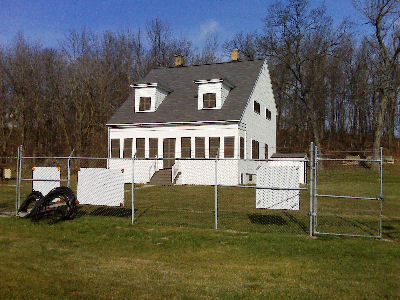
Rapid Croche Locktender House
References
Ackerman, J.D., C.M. Cotrell, C.R. Ethier, D.G. Allen and J.K Spelt,. 1995. A wall jet to measure the attachment strength of zebra mussels. Can. J. Fish. Aquat. Sci. 52: 126-135.
Aladin, N. Laboratory of Brackish Water Hydrobiology, Zoological Institute of RAS, Universitetskaya nab. 1, 199034, St.Petersburg, Russian Federation
(812)328-46-09; aral@zin.ru
Brock, T. D. 1967. Micro-organisms adapted to high temperatures. Nature 214:882-885
Castenholz, R. W. 1969. Thermophilic blue-green algae and the thermal environment. Bacteriol. Rev. 33:476-504
Branstrattor, D. University of Minnesota, Duluth, dbranstr@d.umn.edu (309) 726-8134
Delorme Mapping. 1992. Wisconsin Atlas and Gazetteer. 3rd ed. P.O. Box 298 Freeport, Maine. 04032
L.D.R. International, Inc. 1993. Fox River Corridor Economic Development Feasibility Study. East Central Wisconsin Regional Planning Commission. EDA Project Number 06-06-02553
MacIsaac, H., Professor and DFO Invasive Species Research Chair; Director, Canadian Aquatic Invasive Species Network, Great Lakes Institute for Environmental Research
University of Windsor, Windsor, ON, Canada N9B 3P4, (519) 253-3000 ext. 3754. hughm@uwindsor.ca
MacNeill, D., M. Snyder, K. Schultz, and J. Makarewicz. 2004. Guidelines for reducing the spread of “Fishhook Waterfleas”. New York Sea Grant. Oswego, NY. 6/04 2.5M
Makarewicz, J.C., E. Damaske, C. Laxson, I. Grigorovich and H.J. MacIsaac. 2002. Seasonal and vertical distribution, food web dynamic and contaminant biomagnifications of Cercopagis pengoi in Lake Ontario. Aquatic Invaders pp 1-6 Vol. 13(3), Fall 2002.
Mills, E. Cornell Biological Field Station, 900 Shackelton Point Rd., Bridgeport, NY 13030
(315) 633-9243, elm5@cornell.edu
McMahon, R.F., T.A. Ussery, A.C. Miller and B.S. Payne. 1993. Thermal tolerance in zebra mussels (Dreissena polymorpha) relative to rate of temperature increase and acclimation temperature. Pages 4-98-4-118 in: J.L. Tsou and Y.G. Mussalli (eds.), Proceedings: Third International Zebra Mussel Conference, 1993, TR- 102077, Electric Power Research Institute, Palo Alto, California.
McMahon, R.F., M. A. Matthews, T. A. Ussery, R. Chase and M. Clarke. 1994. Further studies of heat tolerance in zebra mussels: effects and temperature acclimation and chronic exposure to lethal temperatures. Pages 251-272 in: Proceedings: Fourth International Zebra Mussel Conference. University of Wisconsin Sea Grant Institute.
Wisconsin Dept. of Nat. Res. 2006. 2006 Wisconsin Fishing Report. Pub-FH-506 2006. 16 pp.
Wong, G.S.1991. High-pressure water jetting and carbon dioxide pellet blasting. Technical Note ZMR-2-04 in Zebra Mussel Research Technical Notes. U.S. Army Corps of Engineers.
Yurista, P. 1999. A model for temperature correction of size-specific respiration in Bythotrephes cederstroemi and Daphnia middendoffiana. J. of Plankton Res. 21(4):721-734.
